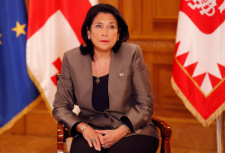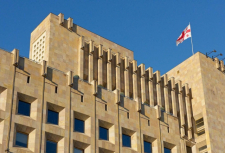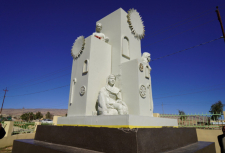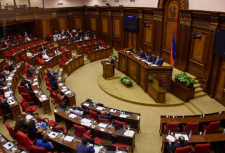Georgian King Tamara and her Yezidi military leaders, who glorified her for centuries
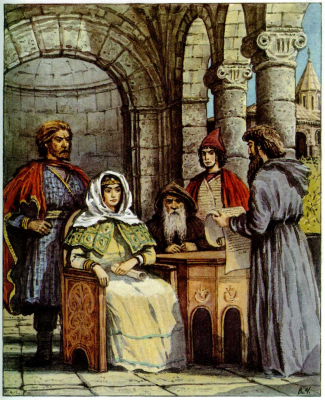
Part-1
For centuries, there has been a dispute over who these legendary warlords of Queen Tamara were, Yezidis or Kurds. Since Georgia was a Christian country, and King Tamara was a Christian, it is unlikely that she would have hired Kurdish Muslims to guard her. Likely, the tsarina's military leaders were Yezidis, some Georgian historians also hold this opinion.
It should also be noted that at that time there was a resettlement of many Yezidi families, not Muslim Kurds. Muslims have never fled to Georgia.
But, unfortunately, in the post-Soviet territory, due to the political interests of the USSR, the Yezidi people were subject to discrimination, and in many historical documents the Yezidis were noted as the Kurdish people.
The Georgian and Yezidi peoples, being very ancient, have influenced each other for many centuries. These two peoples, at certain stages of their development, intertwined like two trees growing side by side, when it is already difficult to understand where the branches of one end and the branches of the other begin. The relationship between Yezidis and Georgians has known both bright and dark periods, but it is safe to say that there were much more bright and sunny days in these relations.
The Golden Age of Georgia was the name of the period of the reign of the Great Georgian Queen Tamara. Legends are made up about her deeds, she is revered as an Orthodox Saint, little is still known about her last days in this world.
But today I want to remember those who do everything to exalt their overlords, who with a hard hand hammer the names of their kings and queens into the glorious historical chronicles, those about whom they say much less than they deserve — brothers John and Zachariah Mkhargdzeli and their father Sargis.
The Zakharyani - Mkhargdzeli clan is of Yezidi origin, their lineage originates from the great ruler of the times of Achaemenid Persia — Artaxerxes I (translated from Persian — Dolgoruky). By the way, shoulder length is one of the meanings of the surnames of Mkhargdzeli. Also, some historians recognize them as descendants of the Artsruni and Bagrationi families. The most prominent orientalist, director of the Hermitage, academician of the USSR Academy of Sciences, Russian scientist of Armenian origin — Joseph Orbeli was a supporter of their Yezidi origin.
This is how historians of the Middle Ages wrote about them:
"At that time there lived glorious princes: Zakare and Ivan, sons of Sargis, Yezidi immigrants who passed to the Dzoro-Get kings from the Bagratuni clan, who converted to the Christian faith and received honors... they gradually achieved high honors as men of high military valor. They became famous under King Tamara, who gave them Lori. In a short time, they took away many fortresses and regions from the Turks..."
Vardan the Great (13th century, Armenian historian)
Coming to the power circles of Georgia
The middle of the XII century was a real test for the whole of Georgia and for the Bagrationi dynasty ruling in it. After the abdication of Tsar Demeter, I (there are versions that under the pressure of the eldest son of David V), David V began to rule Georgia, to whom fate allotted six months of the kingdom, and after he died, leaving behind a minor son of Demeter. Therefore, David's younger brother, George III, ascends to the throne.
But when Demeter comes of age, George III does not concede the throne.
There is a dual power in the country: on the one hand, Princes Orbeli and young Demeter, on the other, Tsar George; on the one hand, 30,000 soldiers, and on the other, 1,000. But Sargis Mkhargrdzeli serves in the ranks of the military leaders of Orbeli, who is not ready to take up arms against the current Georgian ruler — he goes over to the side of the tsar, and after his example many will follow, and now the princes of Orbeli have no advantages. And Sargis Mkhargrdzeli leads troops against the rebels.
A little time will pass and the rebellion will be brutally suppressed: almost the entire princely family of Orbeli was exterminated, only those who fled to neighboring kingdoms were saved. And Sargis, who defected to George's side, was one of the first, at a time when the tsar did not have an army — princely possessions in Lori were granted, he was also the governor of the ancient city of Ani. From that moment on, there was no family closer to the kings of Georgia than the Zakaryani-Mkhargrdzeli clan. Sargis, and after his illustrious sons Zacharias and John, became the commanders-in-chief of the Georgian troops first, and then, during the period of the greatest power of the kingdom, the Georgian-Armenian troops.
But that's all later, but for now, George III wondered what would happen after him. And in 1173, he decided to declare his eldest daughter, Queen Tamara, as his co-ruler. He has long seen in her what is hidden from others: a sharp mind, attentiveness, tolerance and other virtues. In a few years of joint rule, all the talents of the young queen will become obvious to others. Together with their father, they will begin the fight against theft, robbery and injustice within the country. They will be able to fulfill this ambitious task: people will look at Tamara as a savior. However, Tamara, like her glorious father George III, was not going to sit out — she wanted to expand the state entrusted to her.
After the death of her father, the radiant queen was so authoritative and impeccable that no one in the whole country even thought of challenging her claim to the throne as the sole heiress: everyone from the poor to the rich welcomed their queen and wished for long years of rule.
The great Tamara did not alienate the people devoted to her father, on the contrary, she surrounded them with even more attention and honor, which strengthened the loyalty of all those close to her: first, the brothers Mkhargrdzeli, who for the entire time of her reign would not let King Tamara feel the bitterness of military defeats. In addition, the tsarina equipped roads, bridges, palaces, many temples and monasteries, which contributed to the spread of Orthodoxy throughout the Caucasus and beyond. Under her, crafts, science, literature, and various forms of art began to develop at an unprecedented pace. At her court were the real luminaries of that time, such as Shota Rustaveli. The legendary work "The Knight in the Tiger Skin" written by him almost immediately became a classic of world literature.
Personal life of the queen
The Great Tamara was married twice: the first husband of the tsarina was the son of the Prince of Novgorod, Yuri Bogolyubsky, who in Georgia began to be called George. The marriage was imposed on the tsarina by the nobility, the so-called Darbazy (Supreme Council of Georgia in the Middle Ages). Nothing good came of it: the young did not find a common language. Tamara was a stateswoman, who cannot be said about George Bogolyubsky, who took the throne for granted. He spent all his time in entertainment and treason, and when the queen expressed her dissatisfaction, Bogolyubsky tried to organize a coup in order to become the sole ruler of the Georgian kingdom. His designs were discovered, and he was banished. As a result, once in Constantinople, George, together with the Greeks, organized a campaign to the lands of his ex-wife.
King Tamara sent a Georgian army headed by her faithful Yezidi, John Mkhargrdzeli, to meet him. Bogolyubsky was defeated, and little is known about his future fate.
By that time, John had already converted to Byzantine Orthodoxy, and his brother Zacharias remained in the parish of the Armenian Apostolic Church, which did not prevent them from fulfilling their duty beyond praise.
The second marriage was different: the queen chose her own betrothed. It turned out to be the Ossetian Tsarevich David Soslan. Finally, the queen had a man who could make her happy. In this marriage, Tamara and David will have two children: a son, George (Lasha) and a daughter, Rusudan.
Tags: #yazidisinfo #history #yazidisofgeorgia #aboutyazidis
Georgian King Tamara and her Yezidi military leaders, who glorified her for centuries

Part-1
For centuries, there has been a dispute over who these legendary warlords of Queen Tamara were, Yezidis or Kurds. Since Georgia was a Christian country, and King Tamara was a Christian, it is unlikely that she would have hired Kurdish Muslims to guard her. Likely, the tsarina's military leaders were Yezidis, some Georgian historians also hold this opinion.
It should also be noted that at that time there was a resettlement of many Yezidi families, not Muslim Kurds. Muslims have never fled to Georgia.
But, unfortunately, in the post-Soviet territory, due to the political interests of the USSR, the Yezidi people were subject to discrimination, and in many historical documents the Yezidis were noted as the Kurdish people.
The Georgian and Yezidi peoples, being very ancient, have influenced each other for many centuries. These two peoples, at certain stages of their development, intertwined like two trees growing side by side, when it is already difficult to understand where the branches of one end and the branches of the other begin. The relationship between Yezidis and Georgians has known both bright and dark periods, but it is safe to say that there were much more bright and sunny days in these relations.
The Golden Age of Georgia was the name of the period of the reign of the Great Georgian Queen Tamara. Legends are made up about her deeds, she is revered as an Orthodox Saint, little is still known about her last days in this world.
But today I want to remember those who do everything to exalt their overlords, who with a hard hand hammer the names of their kings and queens into the glorious historical chronicles, those about whom they say much less than they deserve — brothers John and Zachariah Mkhargdzeli and their father Sargis.
The Zakharyani - Mkhargdzeli clan is of Yezidi origin, their lineage originates from the great ruler of the times of Achaemenid Persia — Artaxerxes I (translated from Persian — Dolgoruky). By the way, shoulder length is one of the meanings of the surnames of Mkhargdzeli. Also, some historians recognize them as descendants of the Artsruni and Bagrationi families. The most prominent orientalist, director of the Hermitage, academician of the USSR Academy of Sciences, Russian scientist of Armenian origin — Joseph Orbeli was a supporter of their Yezidi origin.
This is how historians of the Middle Ages wrote about them:
"At that time there lived glorious princes: Zakare and Ivan, sons of Sargis, Yezidi immigrants who passed to the Dzoro-Get kings from the Bagratuni clan, who converted to the Christian faith and received honors... they gradually achieved high honors as men of high military valor. They became famous under King Tamara, who gave them Lori. In a short time, they took away many fortresses and regions from the Turks..."
Vardan the Great (13th century, Armenian historian)
Coming to the power circles of Georgia
The middle of the XII century was a real test for the whole of Georgia and for the Bagrationi dynasty ruling in it. After the abdication of Tsar Demeter, I (there are versions that under the pressure of the eldest son of David V), David V began to rule Georgia, to whom fate allotted six months of the kingdom, and after he died, leaving behind a minor son of Demeter. Therefore, David's younger brother, George III, ascends to the throne.
But when Demeter comes of age, George III does not concede the throne.
There is a dual power in the country: on the one hand, Princes Orbeli and young Demeter, on the other, Tsar George; on the one hand, 30,000 soldiers, and on the other, 1,000. But Sargis Mkhargrdzeli serves in the ranks of the military leaders of Orbeli, who is not ready to take up arms against the current Georgian ruler — he goes over to the side of the tsar, and after his example many will follow, and now the princes of Orbeli have no advantages. And Sargis Mkhargrdzeli leads troops against the rebels.
A little time will pass and the rebellion will be brutally suppressed: almost the entire princely family of Orbeli was exterminated, only those who fled to neighboring kingdoms were saved. And Sargis, who defected to George's side, was one of the first, at a time when the tsar did not have an army — princely possessions in Lori were granted, he was also the governor of the ancient city of Ani. From that moment on, there was no family closer to the kings of Georgia than the Zakaryani-Mkhargrdzeli clan. Sargis, and after his illustrious sons Zacharias and John, became the commanders-in-chief of the Georgian troops first, and then, during the period of the greatest power of the kingdom, the Georgian-Armenian troops.
But that's all later, but for now, George III wondered what would happen after him. And in 1173, he decided to declare his eldest daughter, Queen Tamara, as his co-ruler. He has long seen in her what is hidden from others: a sharp mind, attentiveness, tolerance and other virtues. In a few years of joint rule, all the talents of the young queen will become obvious to others. Together with their father, they will begin the fight against theft, robbery and injustice within the country. They will be able to fulfill this ambitious task: people will look at Tamara as a savior. However, Tamara, like her glorious father George III, was not going to sit out — she wanted to expand the state entrusted to her.
After the death of her father, the radiant queen was so authoritative and impeccable that no one in the whole country even thought of challenging her claim to the throne as the sole heiress: everyone from the poor to the rich welcomed their queen and wished for long years of rule.
The great Tamara did not alienate the people devoted to her father, on the contrary, she surrounded them with even more attention and honor, which strengthened the loyalty of all those close to her: first, the brothers Mkhargrdzeli, who for the entire time of her reign would not let King Tamara feel the bitterness of military defeats. In addition, the tsarina equipped roads, bridges, palaces, many temples and monasteries, which contributed to the spread of Orthodoxy throughout the Caucasus and beyond. Under her, crafts, science, literature, and various forms of art began to develop at an unprecedented pace. At her court were the real luminaries of that time, such as Shota Rustaveli. The legendary work "The Knight in the Tiger Skin" written by him almost immediately became a classic of world literature.
Personal life of the queen
The Great Tamara was married twice: the first husband of the tsarina was the son of the Prince of Novgorod, Yuri Bogolyubsky, who in Georgia began to be called George. The marriage was imposed on the tsarina by the nobility, the so-called Darbazy (Supreme Council of Georgia in the Middle Ages). Nothing good came of it: the young did not find a common language. Tamara was a stateswoman, who cannot be said about George Bogolyubsky, who took the throne for granted. He spent all his time in entertainment and treason, and when the queen expressed her dissatisfaction, Bogolyubsky tried to organize a coup in order to become the sole ruler of the Georgian kingdom. His designs were discovered, and he was banished. As a result, once in Constantinople, George, together with the Greeks, organized a campaign to the lands of his ex-wife.
King Tamara sent a Georgian army headed by her faithful Yezidi, John Mkhargrdzeli, to meet him. Bogolyubsky was defeated, and little is known about his future fate.
By that time, John had already converted to Byzantine Orthodoxy, and his brother Zacharias remained in the parish of the Armenian Apostolic Church, which did not prevent them from fulfilling their duty beyond praise.
The second marriage was different: the queen chose her own betrothed. It turned out to be the Ossetian Tsarevich David Soslan. Finally, the queen had a man who could make her happy. In this marriage, Tamara and David will have two children: a son, George (Lasha) and a daughter, Rusudan.
Tags: #yazidisinfo #history #yazidisofgeorgia #aboutyazidis

